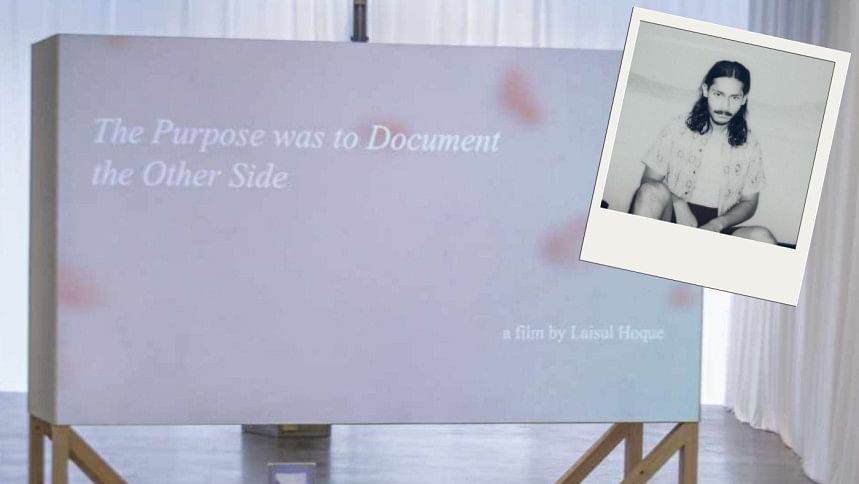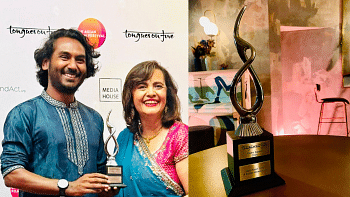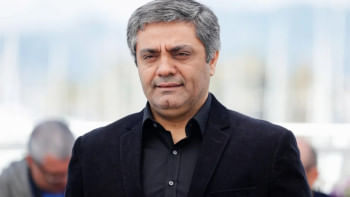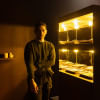‘The Purpose Was to Document the Other Side’: A tale of mediating generational gaps

The differences in culture, art, expression, innovation, religion, and moral values are often referred to as the 'Generational Gap'. When one generation's beliefs and morals don't align with those of the next, a gap forms, potentially leading to generational conflict.
Exploring the themes of communication and miscommunication, promising visual artist Laisul Hoque created a film in 2023 titled "The Purpose Was to Document the Other Side", based on his mother's journey to London. This film was screened in three independent galleries in Dhaka.

The first screening of the 15-minute short film took place on May 13 at Ekshoek and concluded with an open discussion led by multimedia artist Shehzad Chowdhury, who draws inspiration from mythology, nature, and the Baul/Fakiri tradition. The second screening occurred on May 14 at Studio 6/6, with artist and gallerist Taiara Farhana Tareque facilitating the discussion. On May 15, the film was screened at Project Banani 18, with Bangladeshi filmmaker Piplu Khan leading the conversation.

London-based Bangladeshi artist Laisul Hoque held his recent exhibitions at the Barbican Centre, Whitechapel Gallery, and OITIJ-JO– a London-based social enterprise promoting contemporary Bengali arts and crafts.
The project was recorded on an old camera, purchased by the artist's father during his work trip to Europe in 2004, where he couldn't bring his family along.
The film contrasts two distinct periods, highlighting the differences between the artist's upbringing and that of his mother. Through this documentary, Hoque aims to help his mother overcome generational trauma and create an opportunity for her to express emotions long suppressed. The film powerfully curates their narrative together, addressing generational trauma and the consequences of emotional distance by sharing memory and authorship.

During the open discussion session on the last day of the screening, Laisul explained, "During my school years, we practiced speaking English, made friends, and learned to express our emotions—bonding in the English language. At home, my mother spoke Bangla. The responsibilities of parenthood made her communicate with authority, being the matriarch. However, in this process, we missed opportunities to express our emotions in Bangla. The influence of globalisation resulted in learning emotive language and communication exclusively in English, a language my mother couldn't speak."

The artist emphasised the communication gap within South Asian families, noting the trauma and unresolved conflicts that arise from this gap. He mentioned, "At times, we distance ourselves from our parents, unable to meet halfway. Yet, we unknowingly carry the weight of that trauma, living with guilt. I didn't want to eternalise this cycle."
"The transformation of my mother from unexpressive to expressive was not possible before. It took growth, intentional efforts to understand and use my mother tongue, and a commitment to reframing communication with empathy. Through these efforts, my mother and I claimed agency over our relationship, fostering open and honest communication. This transformation allowed her to feel comfortable visiting me in London," Laisul added.
By deciding to record and hold these footages with the camera his father used, Hoque provides his mother with a space to share her narrative, traditionally dominated by his father and himself.
At the end of the film, he hands the camera to his mother, allowing her to contribute to the narrative. This gesture also nods to "Cinematography by Runa Islam", the inaugural artwork that incorporated intertextuality into camera movement.

People of every generation face existential crises, which have shaped human civilisation from the Renaissance to the postmodern era. While many families today seem fragmented, earlier generations experienced different dynamics. In the film, the artist's mother reflects on the meaning of life, emphasising sacrifice and compromise. She explains that while anger is a natural human response, staying silent and listening when a partner is angry can normalise situations and strengthen relationships.

Laisul artistically portrays the difference between communication and miscommunication in this film. According to him, anger is a feeling that can be controlled by silence. Maintaining silence until the right moment for communication can effectively address miscommunication. Simultaneously, he emphasises the importance of being expressive to understand and be understood.
During the open discussion session, intellectuals also highlighted the 'kids these days' effect, focusing on generational conflict within the socio-economic context. Unlike their parents, today's youth often face depression and insomnia, possibly due to not having the same financial responsibilities.
The film screening and discussion session featured popular Bangladeshi musician Ahmed Hasan Sunny, journalists, and other intellectuals.

Laisul Hoque completed both his O levels and A levels from the Bangladesh International Tutorial (BIT). He earned a BA in English Literature from North South University and pursued higher studies abroad, obtaining a dual Masters in Contemporary Photography; Practices and Philosophy from Central Saint Martins, University of the Arts London.
The artiste is now working towards becoming an internationally recognised contemporary Bangladeshi artist, focusing on building an art career in both the UK and Bangladesh. He is also exploring the concept of listening as an art practice.

 For all latest news, follow The Daily Star's Google News channel.
For all latest news, follow The Daily Star's Google News channel. 






Comments